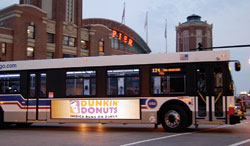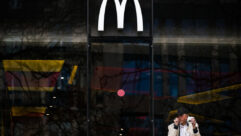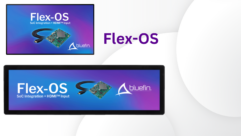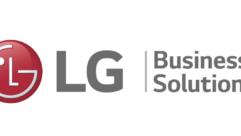

Throwing Signage on the Bus
Faced with budget shortfalls, Chicago has quit plowing side streets to save money. But the snow and cold were made a bit more tolerable for some of the city’s public transit passengers, thanks to Kraft Foods, which provided heat at some bus shelters as part of an ad campaign for Stove Top Stuffing.
Titan Worldwide and U.K.-based Litelogic have installed digital signage systems on the sides of Chicago buses.
Credit: Courtesy Titan Worldwide
Faced with budget shortfalls, Chicago has quit plowing side streets to save money. But the snow and cold were made a bit more tolerable for some of the city’s public transit passengers, thanks to Kraft Foods, which provided heat at some bus shelters as part of an ad campaign for Stove Top Stuffing.
Kraft says it’s the first time that heat has been used in bus shelter advertising (when the ad campaign ends, so does the heat, alas). Expect more out-of-the-box thinking from advertisers–and from cities willing to allow advertising on just about any municipal property in an effort to boost revenues.
That includes on buses themselves. In Chicago and New York, Titan Worldwide, an agency specializing in transit advertising, recently added digital signage to the sides of buses. The systems use global positioning system (GPS) receivers to serve ads based on the location of a bus at a particular moment. For example, when an equipped bus passes through Manhattan’s Chelsea neighborhood, its signage displays ads for businesses located in that area. Or when the bus passes through a neighborhood with a high Hispanic population, ads could be refreshed with Spanish-language versions.
“We’ve already got tons of advertisers that are very happy with the performance of [static, print] advertising on buses,” says Lou Giacalone, senior vice president for digital at New York-based Titan. “This takes it to the next level: It’s brighter. It’s moving. It catches your eye. So it takes an already active medium and pumps it up that much more.”
Light But Rugged
Hanging digital signage on the side of a bus poses a few challenges. For example, the displays have to be thin enough–about 1 inch–that they don’t stick out to the point that they risk getting sheared off when the bus makes a tight turn. The displays also have to be more rugged than regular digital signage designed for outdoor applications.
“It’s got to be able to withstand the elements–not just the natural elements, [but also] the bus-wash machine at the end of every shift,” says Giacalone, who created the CoolSign digital signage software before joining Titan. “There are a lot of factors that go into the design.”
Weight and power are two more considerations. Although fuel prices have plummeted recently, transit authorities are still wary of extra weight that could crimp mileage. The displays and the adjunct hardware also have to be power-efficient to avoid taxing the bus’ battery and alternator.
Titan’s system, which could be on as many as 200 New York City buses by the end of this quarter, uses hardware and software from Litelogic, a U.K. company. Offered as a turnkey package, Litelogic’s Evolution 180 bus platform consists of:
- 21-millimeter-thick displays that use Litelogic’s proprietary LED technology. In the Titan deployments, each display is 30 inches by 144 inches, with a 12 millimeter pixel pitch. “We’re looking to get an 8 millimeter design fielded because we think that extra resolution is going to help,” Giacalone says.
- A GPS receiver and wireless modem, which are used to download ad content. The modem is available in a variety of standards, including cellular and Wi-Fi, so there’s the flexibility to pick the service provider that offers the lowest fees or fastest network. (For more information about today’s wireless technologies and each one’s capabilities, see “Along for the Ride,” October 2008.)
- A computer that hosts the media player that feeds ads to each display. It’s housed in the same unit as the wireless modem and GPS receiver.
The system is sold as a package that includes installation, maintenance, and wireless service. The price tag varies significantly–from $20,000 to $100,000 per bus–based on factors such as how much the wireless carrier charges Litelogic.
“The wireless medium is essentially transparent to the system,” says James Sirmon, Litelogic’s co-founder and innovations director. “Wireless network operators typically offer a “floating” IP address by default, and a fixed one as part of a more expensive Business Class service. Litecast [content management software] supports both. The minimum bandwidth required is one that will allow content to be delivered before it is scheduled to begin playing. This actually depends more on the amount of content being transferred than the bandwidth itself. But of course, the faster the better.
It’s also possible to have the system configured with multiple wireless modems. For example, big image or video files could be downloaded over a cheap Wi-Fi connection at night when the bus is parked at the depot, with smaller updates downloaded over cellular during the day.
That scenario illustrates some of the technological and business variables that AV pros need to be aware of when getting into the mobile signage market.
Throwing Signage on the Bus
Faced with budget shortfalls, Chicago has quit plowing side streets to save money. But the snow and cold were made a bit more tolerable for some of the city’s public transit passengers, thanks to Kraft Foods, which provided heat at some bus shelters as part of an ad campaign for Stove Top Stuffing.
But how small a piece? Civilian GPS technology can pinpoint a location down to an area about the size of a tennis court, so in theory, it’s possible to refresh ads multiple times each block–say, for Starbucks at one end and Dunkin’ Donuts at the other.
New Territory
Litelogic’s system enables what is sometimes called “geo-specific” buys. “We can sell advertisers just a certain piece of geography,” says Titan’s Giacalone.
A Norwegian tour company uses Omnivex software and wireless connections for signage inside its buses.
Credit: Courtesy Omnivex
In reality, that geographic granularity is unwieldy, which is why Titan currently sells ads on a neighborhood level rather than by the street or even parts of streets. “It gets overly complicated to try to sell it at that point and manage the inventory if you’ve got it fragmented down to little bits of blocks,” Giacalone explains.
But even the neighborhood level provides new targeting options that some advertisers seek.
In major cities, for example, some neighborhoods often have high concentrations of a certain ethnicity. So if an advertiser wants to target that demographic, then bus signage provides a compelling option, one that might get more attention than billboards simply because it’s new and unusual.
Even so, it’s possible that future campaigns could be more granular.
“We are approaching the specific characteristics of GPS in New York and Chicago on a ‘see what works’ basis,” says Litelogic’s Sirmon. “In other words, we’re starting with geographically simple campaigns and will work with Titan to see what degree of location-specificity we can achieve. We have some extremely precise reporting tools that track the exact time and location of GPS-aware content playback.”
Wireless connectivity also creates the option of refreshing content frequently. For example, after 4 p.m. Eastern, when the major U.S. stock exchanges end trading, a brokerage’s ad could be refreshed with the day’s closing market levels.
Mobile signage also is a way to get around some cities’ bans and moratoriums on new billboards. In Los Angeles, new billboards are banned through early summer while the city rewrites ordinances to address citizen concerns about visual clutter from too many billboards.
Inside Job
Other vendors are focusing on wireless digital signage inside buses. For example, the Fjord1 tour company uses signage aboard its 400-plus buses in Norway.
Like the Titan deployment, the Fjord1 system uses a PC-based server that downloads content via cellular or Wi-Fi, depending on factors such as file size and timeliness.
“The live data portion updates more often and requires low bandwidth,” says Jeff Collard, president of Toronto-based Omnivex, whose software handles tasks such as downloading. “The larger content files will typically load when the bus is at the terminal, but updates on the road can be pushed out if necessary.”
The system uses a GPS receiver to serve schedules and other information–such as restroom availability–tailored for each point-of-interest stop on a tour, as well as local and national news. The whole set-up costs around 5,500 to 6,500 Euro per bus, or about $7,000 to $8,250.
“The screens are normally installed by the bus vendor, [such as] Scania and Volvo,” says Geir Ove Finstad, managing director of Hatteland Vision, the integrator on the Fjord1 project. “But we will also install in older buses.”
Hatteland Vision is putting together a version for smaller vehicles, such as taxis. That system would add driver ID tags with embedded radio frequency identification (RFID) technology that has the signage display the driver’s photo. “The customer can verify if the right person is driving the cab,” Finstad says.
Regardless of the vehicle, the system also could be used for location-based advertising. “It may be combined with other pieces of data, such as time and weather, to select the most appropriate ad,” Collard says. “If it is a hot sunny day, the McDonald’s ad might feature ice cream at certain times and a cold drink with a full meal at other times. When the buses drive through the mountains, the screen may start advertising the chalet bar and nightlife when the bus is 30 minutes from the ski hill.”
Tim Kridel is a freelance writer and analyst who covers AV, telecom, and information technology. He’s based in Columbia, Mo.










